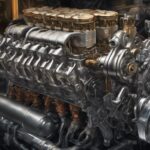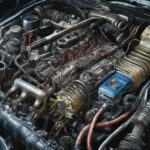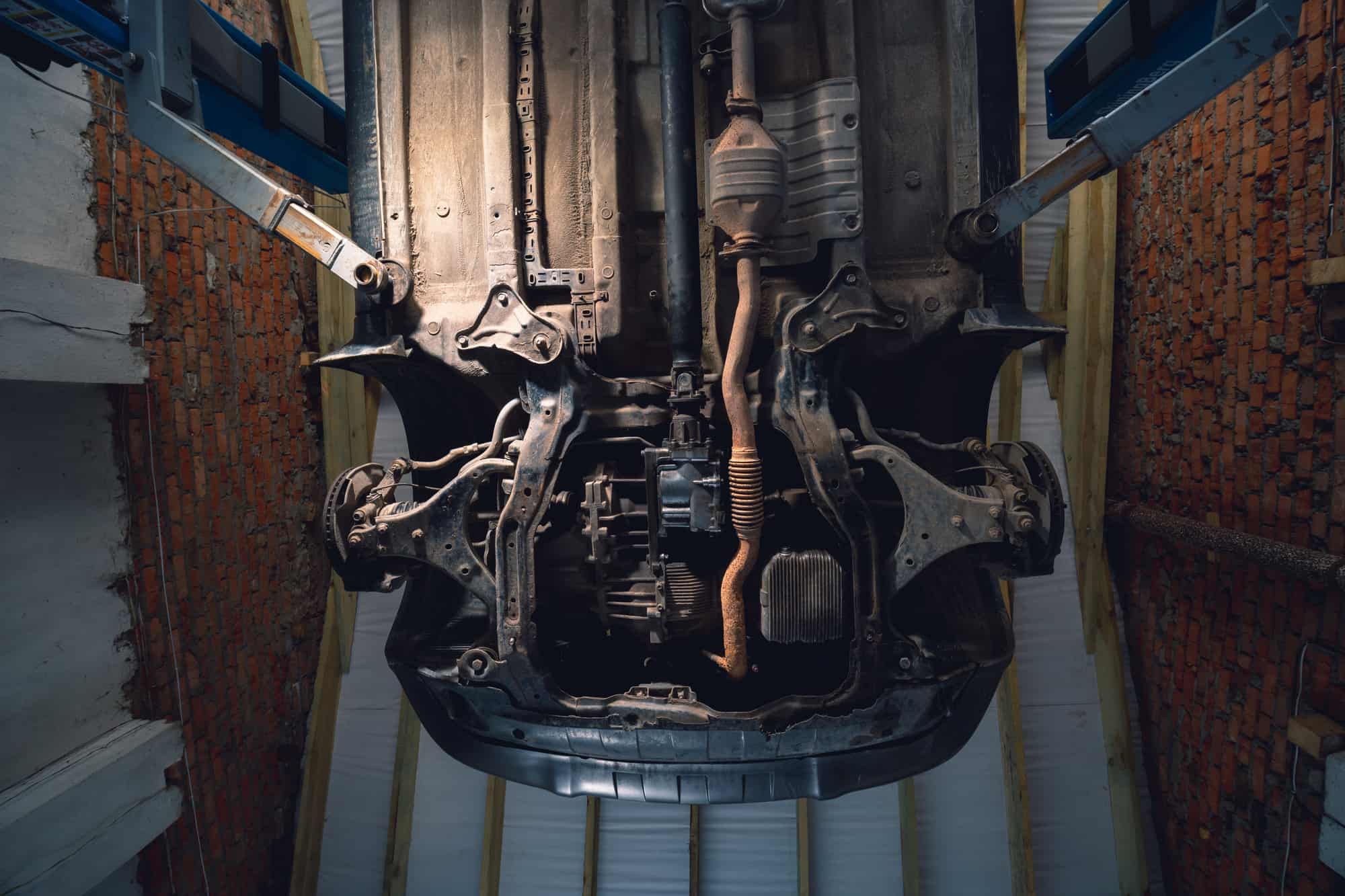A clogged catalytic converter is bad news for your engine and for your pocket. If your car is showing the symptoms of a blocked catalytic converter, then it may be beyond repair and may need replacing. But, what will happen if your car is still running and you don’t replace the catalytic converter?
If your catalytic converter is clogged and you do not replace it then you run the risk of damaging the engine, the exhaust manifold, and the underbody of the car. A blocked cat will generate excessive heat and backpressure in the tailpipe that will cause heat damage in the surrounding area and will affect the running of the engine.
A bad catalytic converter will only get worse over time. If it is overheating when the engine is running this will cause further damage to its internal honeycomb filtering material. Catalytic converters typically run at around 1200 degrees Fahrenheit. A blocked converter may exceed 2000 degrees and actually turn red hot.
Do I really need to replace my catalytic converter?
If your car’s catalytic converter is running hot and is blocked then you will need to take action. Leaving a partially blocked catalytic converter will eventually cause it to become fully blocked. Catalytic converters don’t normally become blocked by themselves, or because of high mileage or age.
If you ignore the problem, the situation is only going to get worse over time, especially if you don’t resolve the engine problem that has caused it in the first instance. Usually, the cause of the problem is a simple one; a fault with the engine that has allowed a continuous leak of contaminants to enter the exhaust pipe.
The most common reasons for a blocked catalytic converter are an engine that is running rich, allowing unburnt fuel to enter the exhaust. It can also be caused by a leaking head gasket, leaking piston rings, or bad valve seals that allow oil or coolant into the fuel mix.
What happens if I dont replace the catalytic converter?
Generally, a check engine light will come on if the engine is running rich, especially if it is misfiring as a result. If the catalytic converter is not filtering the exhaust fumes as it should, then the oxygen sensors will also trigger the check engine light.
It’s usually not a good idea to continue driving for any length of time if the check engine light is on. At some stage, the engine is going to have trouble starting and if the catalytic converter becomes totally blocked, then the engine is not going to run for any length of time at all.
Here are a few problems that will more than likely continue to develop if the problem with the catalytic converter is not resolved.
Problem 1. Continuous Check engine light on the dashboard
The check engine light is often the first sign of something wrong with the engine or the catalytic converter. It will usually illuminate for one or two reasons. To begin, the engine may have a problem that is causing it to misfire and run rich.
This can be caused for many reasons such as bad spark plugs, bad ignition coils, blocked fuel injectors, or a failed engine sensor. If the catalytic converter becomes damaged because of the engine fault, then the oxygen sensors are also going to alert the ECU to the problem, further compounding the issue.
A check engine light will often cause the vehicle to run in ‘safe’ or ‘limp home’ mode to protect the engine from further damage. Until the issue is resolved with the engine and the catalytic converter, the engine will not perform normally.
Problem 2. Engine runs lean all of the time
Sometimes the initial damage to the catalytic converter is caused by an engine that is running rich. The ECU will more than likely try to compensate for the blocked catalytic converter by decreasing the amount of fuel in the fuel mixture.
The reason why the ECU will make the engine run lean is that the blocked catalytic converter will affect how accurately the oxygen sensors work. There are oxygen sensors fitted before and after the catalytic converter. A catalytic converter will generally turn the nitrogen oxide in the exhaust fumes into nitrogen and oxygen.
If it is not working as well as it should, then there will be less oxygen than expected in the post-cat exhaust fumes. This can fool the ECU into thinking that there is too little oxygen in the initial fuel-air mix, hence the reduction in fuel.
An engine that runs lean (too little fuel) can cut out frequently or even fail to start. It may also damage the spark plugs over time.
Problem 3. Damage to exhaust manifold
A blocked catalytic converter can also damage its surrounding parts if it overheats. The exhaust manifold on most cars is located near the catalytic converter and this can easily overheat causing it to crack if it is continuously exposed to very high temperatures.
The symptoms of a bad exhaust manifold include visible cracks where exhaust smoke can escape from. There will also usually be a burning smell when the engine is running, accompanied by a smell of exhaust fumes and a louder than normal exhaust noise. Leaks in the exhaust manifold will also cause
In many vehicles, the exhaust manifold and catalytic converter are closely joined together and cannot be separated. This is done by the manufacturer so that the catalytic converter gets up to temperature more quickly, thus reducing emissions more, especially when the engine is cold.
This however means damage to either part can be expensive to fix as the whole exhaust assembly may need to be replaced.
What Next – Can you fix a Catalytic converter without replacing it?
Most of the time a bad catalytic converter will need to be replaced. Usually, the internal honeycomb filter will fail in one of three ways, it will become blocked, it breaks up into smaller pieces or it melts and fuses together.
If you catch the problem early then it may be possible to clean the filter before it cracks or melts. Usually, the reason for permanent damage to its internal structure is a blockage caused by contaminants such as excess fuel or leaking coolant or engine oil in the exhaust fumes.
If the problem is left unresolved then the catalytic converter will start to overheat and this is what causes the permanent damage.
If there is a problem with the catalytic converter then there are usually 3 options when it comes to fixing the issue.
1. Try to clean or unblock it.
Sometimes a catalytic converter can be saved by cleaning or unblocking it. You can purchase ‘catalytic converter cleaners’ that you add to the fuel system that ‘clean’ as you drive the vehicle.
These work by using ingredients called catalysts that convert hydrocarbons, nitrogen oxide, and carbon deposits into water, CO2, and nitrogen exhaust gases. Most of the time, these products will not completely clean the catalytic converter and will only temporarily improve the situation.
The best way to clean a catalytic converter is to remove it completely from the vehicle. The inside of the converter can then be cleaned by soaking it in an appropriate solvent cleaner and then rinsing with a power washer.
2. Replace the catalytic converter
If cleaning doesn’t fix the problem then you’ll need to replace the cat with a new one. This can be expensive, but it guarantees a fix for the problem. If you do decide to replace the catalytic converter, then make sure that the initial cause of the failure is also addressed.
This may be a problem with the engine running rich or a leak such as a blown head gasket or bad valve seals. It is also best practice to replace the oxygen sensors too as they may also be damaged, especially if the old catalytic converter was running hot for a long time.
3. Remove the catalytic converter entirely and replace with a pipe
Although this sounds like a cheap and easy solution, it’s actually not, and it may be illegal depending on where you live.
Driving without a catalytic converter fitted is technically possible, but it usually causes problems with how well the engine operates and you’ll need to update the ECU in order to turn off the check engine light that will be permanently lit. Some engines will go into a permanent state of limp home mode. This is to protect the engine from damage that may be caused by it running lean if there is no catalytic converter attached.
Your car will also almost definitely fail an emissions test if there is no catalytic converter fitted. This can result in fines and other penalties depending on where you live.
Related Questions – What will happen if I don’t replace my catalytic converter?
1. Can a bad catalytic converter damage my engine?
Yes, a bad catalytic converter will damage an engine in the long term, and at best affect engine performance in the short term. A bad catalytic converter can cause an engine to overheat, and this can cause serious and often irreversible damage to the engine.
One common side effect of a blocked catalytic converter is an engine that runs lean. This is often caused by an over-compensation by the ECU due to out-of-range voltage readings from the oxygen sensors. If the engine is allowed to run lean over a long period of time, a lack of sufficient fuel can damage the spark plugs and the inside of the combustion chambers.
When fuel passes into each engine cylinder it temporarily cools and lubricates the top of the piston and the inside of the cylinder wall. A lack of fuel can cause excessive wear of engine components and it may lead to seizing of the pistons, especially if the coolant system is not operating at 100%.
A bad catalytic converter will also usually run hot, and this can lead to the exhaust manifold and the engine overheating. If this happens every time the engine runs, then damage to the engine will inevitably occur.
2. Can a bad catalytic converter cause a blown head gasket?
A bad or clogged catalytic converter could cause a blown head gasket due to it causing the engine to overheat, however, this is very unlikely in practice.
It is true that a blocked catalytic converter can run red hot, causing an engine to overheat especially when driving slowly or if you are stuck in traffic. It’s unlikely the engine will get hot enough to damage the cylinder head and head gasket. In most cases, a properly functioning coolant system will keep an engine from overheating.
It is possible for a blown head gasket to damage a catalytic converter if the gasket allows coolant or oil to leak into the exhaust manifold.







Is it possible for a catalytic converter problem to cause my car to fail an emissions test even if there are no visible symptoms or warning lights indicating a problem with the converter?
Is it possible for regular maintenance checks to identify a clogged catalytic converter before it starts showing severe symptoms?